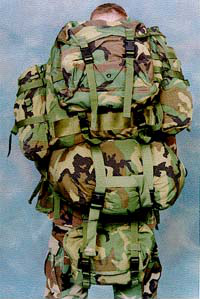Integrated Individual Fighting System
In 1988, the Integrated Individual Fighting System (IIFS) was adopted by the Army. The design was based on commercial backpacks modified for military use with the addition of a special fighting vest and a detachable patrol pack. The original focus was to develop a load-carrying system for use in cold weather. However, in the final analysis, the Army selected the new internal frame system as a replacement for the external framed All-purpose Lightweight Individual Carrying Equipment system.[1]
The IIFS was designed to improve efficiency through more even distribution of the load weight and reduced bulk. The components of the system are constructed of lightweight materials to reduce overall weight.
The system replaced the concept of a shoulder-harness and equipment belt design with concept of a tactical load bearing vest.[2]
Components
The IIFS is composed of eight separate equipment and clothing items that, when used together will lighten individual combat loads.
- Load Bearing Components
- Individual Tactical Load Bearing Vest (ITLBV)
- Grenade Carrier Vest
- Field Pack, Large, with Internal Frame (FPLIF), which is also known as Combat Field Pack M1990 (CFP-90).
- Extreme Cold Weather Sleeping System
- ECW Sleeping Bag
- Bivy Cover
- Hood and Socks
- Stuff Bag
Instruction
- Use and Care of the Integrated Inidividual Fighting System
- TM 10-8400-203-23. 1990. Chapter 21.
Replacement
Reference
- Infantry. July-August 1989. page 8. https://books.google.co.jp/books?id=xSl3aJ4FS-MC&lpg=RA3-PA8&pg=RA3-PA8#v=onepage&q&f=false
Notes
- ↑ Sampson, James B. Lessons Learned During the Development of the Modular Lightweight Load-Carrying Equipment System. US Army Natick Soldier Center. [pdf]
- ↑ Cole, David. (2007). The Survey of U.S. Army Uniforms, Weapons and Accoutrements. p. 119. http://www.history.army.mil/html/museums/uniforms/survey_uwa.pdf



